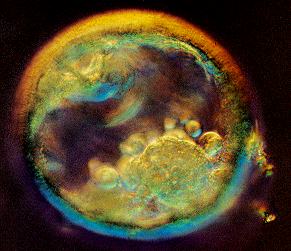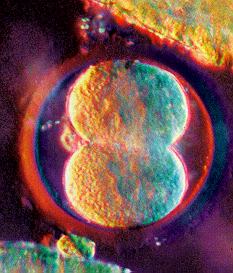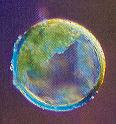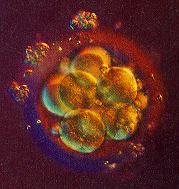































|
 March/April, 1998 Volume XII Number 11
March/April, 1998 Volume XII Number 11
ARTIFICIAL FERTILIZATION

and the
Christian Response
by Chris Kahlenborn M.
Artificial fertilization or artificial reproduction can be a tempting consideration for the couple who has spent years suffering with the emotional pain of infertility, however, a number of ethical questions arise. In order to understand why participation in artificial reproduction conflicts with the Lord's moral order, we must understand how artificial reproduction works.
Artificial fertilization is often abbreviated as ART (assisted reproductive technology). It is a process in which the gametes (i.e., the sperm and the egg) are artificially manipulated so as to increase the likelihood of pregnancy. [Note: the technical name of the egg is an "oocyte"]. There are three main types of ART which are used today.
In vitro fertilization (IVF) literally means fertilization that occurs "in a glass" or in a "test tube." It involves a number of steps. First a woman is given a hormonal drug such as hMG (human menopausal gonadotropin) to make her "super-ovulate." This means that the drug(s) cause her ovaries to produce many "ripe eggs" also called "mature oocytes." She is also given progesterone, a female hormone that serves to thicken the lining of the uterus, preparing it for the unborn baby. The process of egg retrieval is performed using a procedure called "ultrasound guided transvaginal oocyte recovery." Here, the obstetrician uses ultrasound to guide a biopsy needle through a woman's vaginal wall and into her ovary. A number of her eggs--from twenty-five to as many as forty are removed from the ovaries.(1)
Each of these oocytes is then placed in a "test tube" to which a certain amount of a man's sperm is added a few hours later. Most of the eggs--about 75%--will be fertilized and often grown in a culture that is supplemented with fetal cord serum (i.e., plasma that was taken from a baby's umbilical cord). These tiny unborn children are often "screened" for genetic defects by examining one of their cells with instrumentation that can analyze the cell's chromosomal characteristics. Unborn babies who have genetic defects such as Down's syndrome or cystic fibrosis are "thrown out."*
The clinician will then inject three or four unborn children into the woman's uterus via a vaginal approach--this is considered "one cycle" or "one attempt." The national "success rate" of a single attempt of in vitro fertilization (IVF) is 16.8%.(2) Only one out of three or four unborn children survive in a given cycle of in vitro fertilization, that is about 28.6% (i.e., 1/3.5). Since the success of an average cycle is 16.8%, it means that only 4.6% (i.e., 28.6% x 16.8%) of the babies actually survive. This means that fewer than one in twenty unborn children survive the process. The remainder of the original 20 to 40 tiny unborn children are placed in a super-cooled freezer--kept at -196 degrees centigrade (3)--in case the initial attempt (cycle) of in vitro fertilization fails. [Of note, one third of the tiny frozen babies will not survive the freezing process]. Williams Obstetrics (1997) notes that the cost of in vitro fertilization and delivery is about $40,000 and increases to over $300,000 for triplets.(4, pg. 865)
What if all three or four of the unborn children survive? For example 5% of the couples who use in vitro fertilization end up with triplets. The clinician will now offer the woman the "option" of "selective reduction" of one or more of her children. This aggressive procedure involves reducing the number of children that the pregnant woman is carrying by piercing a large bore needle
 through a woman's abdominal cavity or vagina and "injecting potassium chloride into the fetal thorax via a needle." [William's Obstetrics, 1997].(4)
through a woman's abdominal cavity or vagina and "injecting potassium chloride into the fetal thorax via a needle." [William's Obstetrics, 1997].(4)
The second major type of artificial fertilization is called ZIFT or Zygote IntraFallopian Transfer. This process is very similar to IVF in that fertilization occurs outside of a woman's body, but the tiny unborn children (i.e., called "zygotes") are now placed into a woman's fallopian tube instead of into her uterus. It carries the same moral problems as IVF.
The last major type of artificial reproduction is referred to as GIFT which stands for Gamete IntraFallopian Transfer. In this procedure, eggs are taken from a woman and are placed in a special pipette with the sperm from a man. The oocyte and the sperm are separated by an air bubble and do not meet as long as they are outside the woman's body. Usually two eggs and the sperm are then injected into both of the woman's fallopian tubes-thus a total of four eggs are injected. The national success rate for GIFT in one cycle has been estimated to be about 26.3%.
There are some who claim that GIFT is "less unethical" than in vitro fertilization or ZIFT, since with GIFT, fertilization occurs within a woman's body, however GIFT is also morally flawed. Why? First, although in GIFT, four oocytes are placed in a woman's fallopian tube, along with a separated sample of sperm, no one is sure of how many of the eggs become fertilized once they are inside a woman's body. A woman's body is the natural place for conception to take place, and so one would think that sperm and eggs could have at least as high a rate of conception as they would in the "test tube setting." But we know that clinicians succeed in fertilizing over 75% of the eggs that are taken from a woman and fertilized in the test tube.(5,6) Thus, it may very well be that often three if not all four of the eggs which were placed in the fallopian tube during GIFT are fertilized. Since three eggs are fertilized in every trial_and since the national success rate for a single cycle or trial of GIFT is only about 26% 3 --it means that many of the babies that were conceived in the fallopian tube, fail to implant into the mother's uterus and die. Specifically, this implies that in order to achieve one successful pregnancy with GIFT, at least 10 unborn children have to be sacrificed (i.e., 33% x 26% = 8.6% of the babies make it, while 91.4% die in the process).
GIFT has two additional problems: 1) occasionally couples elect to have some of their gametes fertilized and stored as frozen unborn children, in case the GIFT procedure fails, so that the process of "egg retrieval" does not have to be repeated; 2) GIFT may also involve "selective reduction" if, for example, all four of the oocytes are fertilized and succeed in implantation. Of note, the multiple pregnancy rate in GIFT is reported to be about 25%.(7)
In addition to the three types of artificial fertilization described above, is there a moral problem with the "fertility pills" such as those used by the McCaughey? It appears that there is--at least when the commonly used fertility drug, Clomid r is used. Why? Clomid ® hyperstimulates a woman's ovaries so that many eggs are produced.
 But Clomid ® also decreases the thickness of the inner lining of a woman's uterus, called the endometrium.(8,9) This is critical since a number of studies (10,11,12) have shown that a thin endometrial lining is far less likely to sustain the unborn child than a thick one. Thus, the evidence supports the notion that Clomid ® allows a much higher rate of abortions to occur than in the natural setting because of its effect on the uterine lining. The Christian should avoid this.
But Clomid ® also decreases the thickness of the inner lining of a woman's uterus, called the endometrium.(8,9) This is critical since a number of studies (10,11,12) have shown that a thin endometrial lining is far less likely to sustain the unborn child than a thick one. Thus, the evidence supports the notion that Clomid ® allows a much higher rate of abortions to occur than in the natural setting because of its effect on the uterine lining. The Christian should avoid this.
One additional procedure called artificial insemination needs to be mentioned. Here a woman chooses to be artificially inseminated (i.e., the sperm is placed into a woman's uterus) by the sperm of a man who is often not her husband. The woman can actually choose the characteristics of the genetic make-up of the man who donated the sperm (i.e. his IQ, his nationality, etc). In addition, since single women often choose this procedure--the unfortunate child often grows up fatherless. Artificial insemination is different than artificial fertilization since only one gamete (i.e., only the sperm) is manipulated in the procedure and the probability for early abortion is theoretically no greater than with a natural conception.
Obviously, these procedures are ripe with moral evils.** Let us explore them and their implications in more detail.
The fact that in vitro fertilization and ZIFT involve outright abortion precludes any further discussion of these methods as a valid option. No one has the authority to take the life of another, no matter how good the intention of wanting to have a child is. God commanded us to be fruitful and multiply, but He also stated that we should not kill. We cannot justify the former by violating the latter. We must obey ALL His commands.
What about GIFT? It was noted that there is an extremely high probability that GIFT involves multiple early abortions but that once the eggs and sperm are injected into the woman's fallopian tube, no one can say exactly how many of the eggs are fertilized. Here we have a case in which all of the evidence strongly supports the statistic that nine unborn children die for every one that survives. The Christian has been given his or her intellect as well as his or her emotions-both to serve and be guided by our Creator. But the degree of emotional pain or hope one experiences cannot justify a complete denial of the evidence that is presented to the intellect.
 Freezing of unborn children is also morally bankrupt. Why? First, because only two-thirds of children survive the freezing process. Any artificial process that results in the death of one out of three babies is certainly inherently evil. But further questions and concerns arise. What happens to these frozen children if the couple conceives and has "fifteen spare children" frozen at 196 degrees centigrade? Do they "give the children away"? throw them away [i.e., precisely this ethical dilemma arose recently when England allowed the killing of many frozen embryos]? What happens if the couple divorces? What happens when a researcher elects to perform "experiments" with the frozen unborn children? (For those in the audience who might think that "researchers and/or doctors would never do that," one need only recall that many of today's abortionists once took an oath in which they once swore to "give no abortive remedy.")
Freezing of unborn children is also morally bankrupt. Why? First, because only two-thirds of children survive the freezing process. Any artificial process that results in the death of one out of three babies is certainly inherently evil. But further questions and concerns arise. What happens to these frozen children if the couple conceives and has "fifteen spare children" frozen at 196 degrees centigrade? Do they "give the children away"? throw them away [i.e., precisely this ethical dilemma arose recently when England allowed the killing of many frozen embryos]? What happens if the couple divorces? What happens when a researcher elects to perform "experiments" with the frozen unborn children? (For those in the audience who might think that "researchers and/or doctors would never do that," one need only recall that many of today's abortionists once took an oath in which they once swore to "give no abortive remedy.")
"Selective reduction": This involves the killing of a child by piercing his or her chest via a steel syringe and injecting potassium chloride and is inexcusable. Couples who have made the mistake of participating in ART should not compound their error by killing another child, in order to increase the "odds" that the remaining children will survive. Of note, 10% of couples who undergo "selective reduction" will lose all of their children in the process (13, pg. 937).
Genetic selection: Here a single cell-of the tiny unborn child is tested for genetic defects. A clinician takes one of the cells from the unborn child when he or she is in the very first few days of life and usually only "eight cells big." (13, pg. 94) Babies who carry the gene for cystic fibrosis, Down's Syndrome, or any other genetic abnormality are destroyed.*
Masturbation: Although this act does not seem to register on the moral Richter scale of many Christians, other Christians consider it an "act that is inherently evil" and can therefore never be justified. Almost every sperm sample is collected via masturbation. The Christian who accepts the truth of the immorality of this act cannot engage in masturbation under any conditions.**
One of the arguments that fertility clinicians use to justify the procedure of artificial reproduction is that even under natural conditions, women often experience frequent miscarriages. Williams Obstetrics (1997) estimates that about 31% of all conceptions end in miscarriage, however they base this estimate upon the estimates of several medical studies.
 The most recent and accurate study appears to be that of Whittaker, et. al., (20) who used sensitive early pregnancy tests to demonstrate that the overall rate of miscarriage is about 20% (i.e., 8% very early miscarriages and 12% clinically obvious miscarriages). The proponents of ART often states that since natural reproductive processes involve early miscarriages, one can justify the former process of artificial reproduction since "both processes involve the death of unborn children after conception."
The most recent and accurate study appears to be that of Whittaker, et. al., (20) who used sensitive early pregnancy tests to demonstrate that the overall rate of miscarriage is about 20% (i.e., 8% very early miscarriages and 12% clinically obvious miscarriages). The proponents of ART often states that since natural reproductive processes involve early miscarriages, one can justify the former process of artificial reproduction since "both processes involve the death of unborn children after conception."
There are however, two major problems with this type of argument. First, even if we use Williams Obstetrics high estimate of a 31% miscarriage rate, clearly the artificial procedures have a far higher death rate. Whereas in the natural setting between 20-31% of unborn babies will die, in a setting such as in vitro fertilization about 96% of the conceived babies will die (i.e., here we factor in those lost in the freezing process). A second reason is that the processes are theologically different. In a natural setting, a couple places themselves under God's natural conditions and cannot avoid an early miscarriage if it occurs. But in artificial reproduction, children get destroyed in a process that God never commanded. As was noted earlier, if an artificial process violates a commandment of God (Thou shall not kill) it cannot be justified even if part of it is consistent with another one of His dictates ("Be fruitful and multiply"). Our actions must be consistent with all of His commands.
In addition to the noted moral problems, both legal and health problems exist. The US has completely shirked its responsibility of establishing legal guidelines as concerns artificial reproduction. Many of the countries of the rest of the world have ethical guidelines concerning ART, with the exception of the US. For example Germany's law states that "any person transferring more than three embryos to a woman within one menstrual cycle will be sentenced on conviction." (17, pg.194) It also states: "Any person producing an embryo capable of differentiation by fertilization of a human oocyte with a sperm of an animal cell ... will be duly punished." (17, pg.193) Australia's "Infertility Act" of 1984 also banned cloning and the fertilization of human gametes with those of an animal 18 and Singapore has similar guidelines. (19) In spite of this, the US remains devoid of any legal guidelines.
Ectopic pregnancy (i.e. a pregnancy that occurs outside of the uterus, usually in the fallopian tubes): Occurs in approximately 3% of GIFT pregnancies and 5% of in vitro pregnancies (13, pg. 940), while about 1% of natural pregnancies end as an ectopic pregnancy (i.e., 11 out of 1,000 pregnancies- information taken from the years 1970-1989 [source Williams Obstetrics, 1997]). Since almost all of the unborn children of an ectopic pregnancy die, we once again find that an artificial process results in a higher rate of mortality for the unborn child than the natural process. In addition: "Ectopic pregnancy remains the second leading cause of maternal mortality in the United States, and is the leading cause of maternal mortality in the first trimester." (4, pg. 609)
Cancer risk: Clomid ® (clomiphene), made by Hoechst, is a fertility drug which acts upon the pituitary gland, so that it increases the hormones involved in ovulation (called LH and FSH), which results in a tremendous increase in ovarian activity. Instead of one oocyte forming in a given cycle, up to 20 or more may form in each ovary. But Clomid ® "is capable of interacting with estrogen receptors."(14) Is there an increased risk of cancer when an artificial hormone reacts with the body's natural receptors and hyperstimulates a woman's ovaries? Already, Whittemore et al found that women who used fertility drugs experienced a 180% increased risk of ovarian cancer than women without infertility and Rossing noted a 130% increased risk (15) (although his result did not achieve statistical significance). In addition, one must wonder what the long term risk of fertility drugs such as Clomid ® are upon the risk of breast cancer. One need only remember a drug called DES (Diethylstilbestrol) which was an artificial estrogen given to women to prevent premature labor and miscarriages in the 1950s-1960s. After twenty five years researchers finally declared that women who had taken it had a 35% increased risk in breast cancer. (16) Will the same thing occur with drugs such as Clomid ® and hMG? Finally, will the children who are born to the women who have recently taken Clomid ® experience an increased risk of cervical and vaginal cancer as did the children of mothers who took DES? Before dismissing this notion one must note that the PDR (Physician's Desk Reference) states that "Newborn rats, injected (with Clomid r) during the first few days of life, also developed meta-plastic changes in uterine and vaginal mucosa..." (PDR, 1997)
 Does HMG (Human Menopausal Gonadotropin-trade name is Pergonal ®) also have a potential to cause ovarian cancer? One would think that a powerful drug which hyperstimulates a woman's ovaries would have been thoroughly tested but the 1997 PDR notes that: "Long-term toxicity studies in animals have not been performed to evaluate the carcinogenic potential of Pergonal ®." This is astonishing considering that the PDR's description of Pergonal ® also notes that: "There have been infrequent reports of ovarian neoplasms both benign and malignant, in women who have undergone multiple drug regimens for ovulation induction; however, a causal relationship has not been established."
Does HMG (Human Menopausal Gonadotropin-trade name is Pergonal ®) also have a potential to cause ovarian cancer? One would think that a powerful drug which hyperstimulates a woman's ovaries would have been thoroughly tested but the 1997 PDR notes that: "Long-term toxicity studies in animals have not been performed to evaluate the carcinogenic potential of Pergonal ®." This is astonishing considering that the PDR's description of Pergonal ® also notes that: "There have been infrequent reports of ovarian neoplasms both benign and malignant, in women who have undergone multiple drug regimens for ovulation induction; however, a causal relationship has not been established."
* This brings us to another important dilemma. About one-third of couples state that they would abort a child with a chromosomal abnormality and this number could increase dramatically after "genetic counseling" is given. It puzzles me that so many people appear to support the effort called "The Human Genome Project"--an effort to identify every human gene. Although finding new genes can eventually help treat people who have a particular gene, it must be obvious to all that many of the newly discovered genes will be used as a "discrimination test of the unborn" which will--and already has--result(ed) in the killing of thousands of children by many western countries such as the US. If I had the chance, I should like to ask Dr. Francis Collins (a reported Christian who leads the project) how he can justify working on a project in the absence of specific legislation which would protect the affected unborn children. Should we not insist that legislation banning any "discriminatory preborn testing" be passed, before the search for a particular gene is started?
** Often a man is asked to donate a sperm sample for analysis if a couple is suffering from infertility. Some Christians have opted to collect a sperm sample in a perforated condom at a time of a woman's cycle in which she is not thought to be fertile, thus leaving open the small possibility of having a child if God so desires. This author is not sure of the complete morality of this procedure but it is obviously better than masturbation.
 1) Robinson BJH. The perioperative nurse's role in assisted-fertility procedures. AORN. 1997; 65: 87-93.
1) Robinson BJH. The perioperative nurse's role in assisted-fertility procedures. AORN. 1997; 65: 87-93.
2) American Fertility Society. Assisted reproductive technology in the US and Canada: 1992 results generated from The American Fertility Society/Society for Assisted Reproductive Technology Registry. 1994; 62: 1121-1128.
3) Hummel WP et al. Assisted reproductive technology: the state of the ART. Annals of Medicine. 1997; 29: 207-214.
4) Cunningham M. et al. Williams Obstetrics (20th Edition)Appleton & Lange. Stamford, CT. 1997.
5) Laufer N et al. The use of high-dose human gonadotropin in an in vitro fertilization program. Fertility and Sterility. 1983; 40: 734-739.
6) Wolf DP et al. Sperm concentration and the fertilization of human eggs in vitro. (?Biology of Reproduction. 1984; 31: 837-848.
7) Abramovici H. et al. Gamete Intrafallopian transfer. Journal of Reproductive Medicine. 1993; 38: 698-702.
8) Yagel S. et al. The effect of ethinyl estradiol on endometrial thickness and uterine volume during ovulation induction by clomiphene citrate. Fertility ans Sterility. 1992; 57: 33-36.
9) Eden JA et al. The effect of Clomiphene citrate on follicular phase increase in endometrial thickness and uterine volume. Obstet. Gyn. 19889; 73: 187-190.
10) Reuter KL et al Sonographic appearance of the endometrium and ovaries during cycles stimulated with human menopausal gonadotropin. J Reprod. Med. 1996; 41: 509-514.
11) Check JH et al Influence of endometrial thickness and echo patterns on pregnancy rates during in vitro fertilization. Fertility and Sterility. 1991; 56: 1173-1175.
12) Check JH et al. The efect of endometrial thickness and echo pattern on in vitro fertilization outcome in donor oocyte-embryo transfer cylce. Fertility and Sterility. 1993; 59: 72-75.
13) Speroff L et al. Clinical Gynecologic Endocrinology and Infertility (5th Edition). Williams and Wilkens. Baltimore. 1994.
14) Physicians Desk Reference (1997): Description of Clomid (R)
15) Mosgaard BJ et al. The impact of parity, infertility and treatment with fertility drugs on the risk of ovarian cancer. Acta Obstet. Gyn Scand. 1997; 76: 89-95.
16) Colton T, Greenberg ER, et al. Breast cancer in mothers prescribed diethylstilbestrol in pregnancy. JAMA, 1993; 269: 2096-3000.
17) Krebs D. News and Views: Reproductive health care policies around the world: Rules and ethics concerning assisted procreation established by the government of Germany. Journal of Assisted Reproduction and Genetics. 1996. 193-195.
18) Kovacs Legislation on the practice of assisted reproduction in the state of Victoria, Australia. J. of Assisted Rep. and Gen. 1996; 13: 5-7.
19) NG et al News and Views: Reproductive health care policies around the world: ART in Singapore. 1996: 13; 527-528.
20) Whittaker PG. Unsuspected pregnancy loss in healthy women. The Lancet. May 21st, 1983: 1126-1127.
OTHER
COVER
STORY
ARTICALS
Making Baby
Breast cancer, abortion, and the pill
The Reproduction Revolution

|
|

